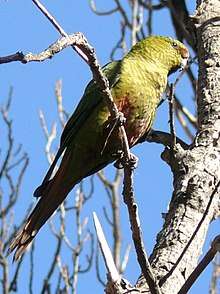Austral parakeet
| Austral parakeet | |
|---|---|
 | |
| Scientific classification | |
| Kingdom: | Animalia |
| Phylum: | Chordata |
| Class: | Aves |
| Order: | Psittaciformes |
| Superfamily: | Psittacoidea |
| Family: | Psittacidae |
| Subfamily: | Arinae |
| Tribe: | Arini |
| Genus: | Enicognathus |
| Species: | E. ferrugineus |
| Binomial name | |
| Enicognathus ferrugineus (Müller, 1776) | |
| Synonyms | |
|
Microsittace ferrugineus[2] | |
The austral parakeet, austral conure, or emerald parakeet (Enicognathus ferrugineus) is a parrot found from the southern tip of South America – further south than any other parrot – to as far north as Temuco. It is a fairly large conure, 35 cm (2 cm more than a monk or quaker parakeet). It is primarily green, lightly barred, with some dull red on the forehead and lores, belly, and upper tail, with the northern part of the range displaying less red.
It occurs mostly in wooded country, but also shrubland and farmland. It stays near sea level in the extreme south, but ranges up to 2000 m at the northern end of its range. Flock size is usually only 10–15 individuals, though flocks over 100 are known. It eats grass and bamboo seeds, nuts, and small fruit, and nests in tree cavities.
There are two recognized subspecies, Enicognathus ferrugineus ferrugineus and Enicognathus ferrugineus minor.
References
- ↑ BirdLife International (2012). "Enicognathus ferrugineus". IUCN Red List of Threatened Species. Version 2013.2. International Union for Conservation of Nature. Retrieved 26 November 2013.
- ↑ Peters, James; Charles Blake (1948). "Microsittace not Different Generically From Enicognathus" (PDF). Auk. 65 (2): 288. doi:10.2307/4080306.
Further reading
- Juniper & Parr: Parrots: A Guide to Parrots of the World; 1998, ISBN 0-300-07453-0
External links
- Austral parakeet videos on the Internet Bird Collection
- Austral parakeet photo gallery VIREO
- Photo-High Res; Article pbase.com–"Patagonian Birds"
